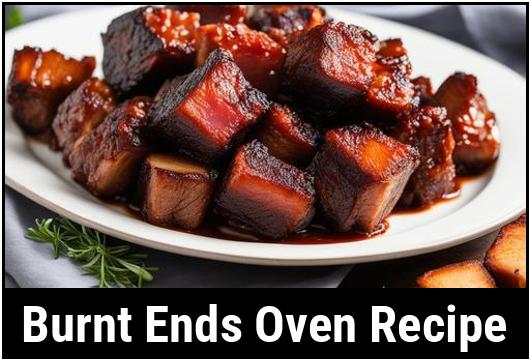
The Perfect Burnt Ends: A Mouthwatering Oven Recipe
Are you ready to embark on a culinary adventure that will satisfy your taste buds like never before? Look no further than the delectable world of burnt ends, a truly irresistible barbecue specialty. In this comprehensive guide, we will delve into the food science behind burnt ends, explore the culinary details that make them stand out, discuss selection and preparation tips, and provide you with a foolproof oven recipe. So, tie up your apron and let’s dive into the world of burnt ends!
Understanding the Food Science Behind Burnt Ends
To truly master the art of preparing burnt ends, it’s essential to have a grasp of the food science involved. Burnt ends, as the name suggests, are traditionally made from the fatty point of a beef brisket. During cooking, the collagen in the connective tissues breaks down into gelatin, imparting moisture and tenderness to the meat. Simultaneously, the excess fat renders, enveloping the meat with rich flavor.
Exploring Culinary Details
Before we jump into the kitchen, let’s explore some crucial culinary details that will elevate your burnt ends to the next level.
Selection
When selecting a beef brisket for burnt ends, opt for a well-marbled piece. The marbling indicates a good distribution of fat, which is essential for achieving that mouthwatering tenderness and flavor. Choose a brisket with a thick fat cap on one side, as this will render down during cooking, ensuring a moist end result.
Cleaning and Preparation
To ensure the perfect burnt ends, thorough cleaning and proper preparation are key.
-
Start by rinsing the brisket under cold water and patting it dry with paper towels.
-
Trim any excessive fat from the surface, but be cautious not to remove all the fat, as this plays a vital role in the dish’s flavor and texture.
-
Next, apply a generous rub of your choice, comprising a blend of spices and seasonings. Popular options include a combination of paprika, brown sugar, salt, pepper, garlic powder, and onion powder.
-
Allow the brisket to rest at room temperature for at least 30 minutes before proceeding.
Tips for a Flavorful Journey
To further enhance your journey through the realm of burnt ends, consider the following tips:
-
Let the seasoned brisket rest in the refrigerator overnight. This allows the flavors to penetrate the meat, resulting in a more intense taste.
-
Consider using wood chips or chunks to infuse your burnt ends with a smoky flavor, even when using an oven. Hickory, mesquite, or oak are excellent choices. Soak the wood chips in water for at least 30 minutes before adding them to the heat source.
-
Adding a small dish of water to your oven while cooking can help maintain moisture levels and prevent the meat from drying out.
-
It’s important to baste the brisket occasionally during cooking to ensure even flavor distribution. A flavorful mop sauce, comprising vinegar, Worcestershire sauce, and spices, can work wonders in this regard.
Achieving the Perfect Doneness
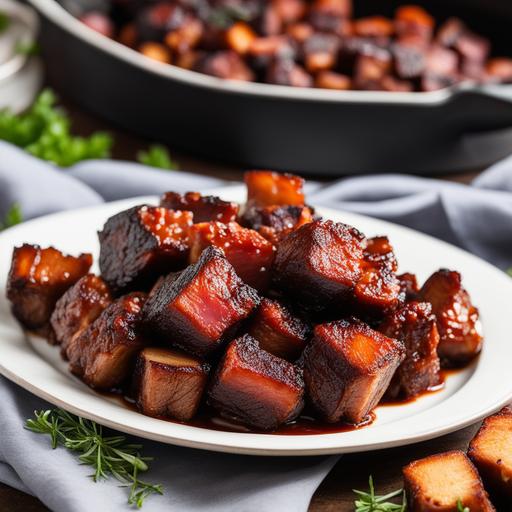
Finding the perfect balance between overcooking and undercooking is crucial when preparing burnt ends. Let’s discuss some doneness checks and considerations to ensure your end result is nothing short of extraordinary.
-
Temperature: Invest in a reliable meat thermometer to monitor the internal temperature of the brisket. Your aim is to achieve an internal temperature of around 195°F to 205°F (90°C to 96°C), which ensures the breakdown of collagen and that melt-in-your-mouth texture.
-
Toothpick Test: Another useful method involves inserting a toothpick into the meat. If it slides in smoothly with little resistance, your burnt ends are ready to be savored. If it meets resistance, allow the meat to cook for a little longer.
A Foolproof Oven Recipe: Bringing it All Together
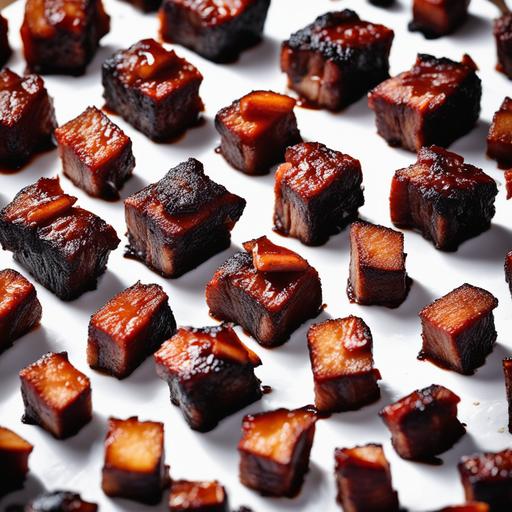
Now that we’ve covered the essential culinary details and doneness checks, it’s time to share a foolproof oven recipe for the ultimate burnt ends experience. Get ready for a journey of flavors!
Ingredients:
-
4 to 6 pounds (1.8 to 2.7 kg) beef brisket
-
¼ cup brown sugar
-
2 tablespoons paprika
-
1 tablespoon salt
-
1 tablespoon black pepper
-
1 tablespoon garlic powder
-
1 tablespoon onion powder
-
2 cups wood chips or chunks (soaked in water for 30 minutes)
-
1 cup water (for the water pan)
Instructions:
-
Preheat your oven to 275°F (135°C).
-
In a small bowl, combine the brown sugar, paprika, salt, black pepper, garlic powder, and onion powder to create the rub.
-
Rinse the brisket under cold water and pat it dry.
-
Apply the rub generously on all sides of the brisket, ensuring even coverage.
-
Place the brisket on a wire rack in a roasting pan, with the fat cap facing upward.
-
Add the soaked wood chips or chunks to a smoking box or wrap them in aluminum foil, poking a few holes to allow smoke to escape. Place the smoking box or foil packet on one side of the oven rack or directly on the oven floor, depending on the oven design.
-
Fill a small oven-safe dish with water and place it in the oven to maintain moisture levels.
-
Insert a meat thermometer into the thickest part of the brisket without touching the bone.
-
Place the roasting pan with the brisket in the preheated oven.
-
Slow-roast the brisket for approximately 1.5 to 2 hours per pound (340 to 450 g), or until the internal temperature reaches 195°F to 205°F (90°C to 96°C).
-
Every hour, baste the brisket with the drippings or mop sauce to enhance flavors.
-
Once the desired internal temperature is reached, remove the brisket from the oven.
-
Let the meat rest, loosely covered with aluminum foil, for at least 30 minutes to allow the juices to redistribute.
-
Slice the brisket into bite-sized cubes, discarding any excess fat.
-
Serve the succulent burnt ends as an appetizer, side dish, or delicious filling for sandwiches. Enjoy!
Variations and Culinary Adventures
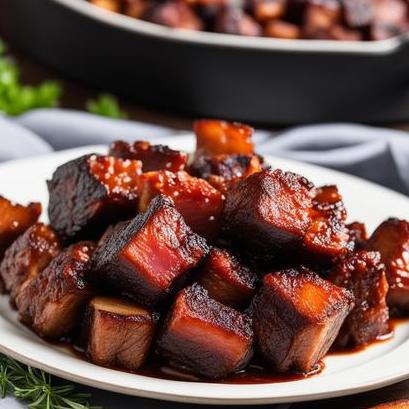
While the traditional burnt ends recipe primarily features beef brisket, don’t be afraid to experiment and embark on culinary adventures. Here are a few variations to consider:
-
Pork burnt ends: Substitute beef brisket with pork belly or pork shoulder for an equally succulent and versatile dish.
-
Smoked burnt ends: If you have access to a smoker, try smoking the brisket low and slow instead of using an oven. The added smoky flavor will take your burnt ends to new heights.
-
Sweet and spicy burnt ends: Elevate the flavor profile by adding a touch of honey to the mop sauce or increasing the amount of black pepper for a spicier kick.
With these variations, you can unlock a multitude of flavor possibilities and enjoy a diverse range of delectable burnt ends.
The Dangers of Overcooking and Undercooking
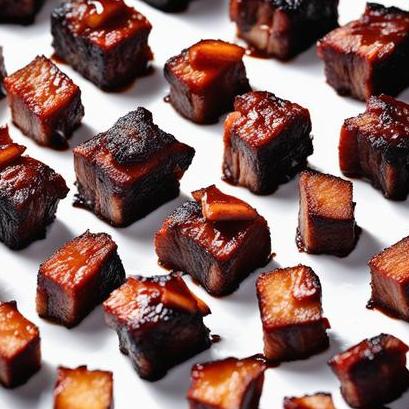
While we strive for the perfect doneness, it’s essential to be aware of the dangers of overcooking and undercooking when preparing burnt ends.
Overcooking can result in excessively dry and tough meat, undoing all your hard work. To avoid this, closely monitor the internal temperature and perform periodic doneness checks. Remember, there’s a fine line between tender and rubbery.
On the other hand, undercooking can result in chewy and unappetizing burnt ends. Take the time to ensure the proper internal temperature is achieved, allowing the collagen to break down fully and create that melt-in-your-mouth texture.
A Flavorful Journey Awaits!
Congratulations! You’ve embarked on a flavorful journey through the world of burnt ends, from understanding the food science to mastering the culinary details. Armed with our comprehensive oven recipe and valuable tips, you’re well on your way to creating mouthwatering burnt ends worthy of any barbecue aficionado’s praise.
Whether you stick to the tradition of beef brisket or dare to venture into new variations, the key lies in your passion for experimentation and attention to detail. So, fire up that oven, enjoy the enchanting aromas, and savor the delicious rewards as you take your taste buds on an unforgettable ride.
Sources
FAQS On Burnt Ends Oven Recipe
What Are Burnt Ends?
Burnt ends are a type of barbeque dish that originated in Kansas City, Missouri. They are made from the ends of smoked beef brisket that have been caramelized, chewy, and have a smoky flavor.
Can I Make Burnt Ends In The Oven?
Yes, burnt ends can be made in the oven. While traditionally they are made on a smoker, the oven can also produce delicious burnt ends with the right recipe and techniques.
How Do I Make Burnt Ends In The Oven?
To make burnt ends in the oven, you will need to slow roast a beef brisket for 4-6 hours at a low temperature, then cut it into cubes and return it to the oven with a sauce or glaze of your choice for an additional 2-3 hours until the edges are crispy and caramelized.
What Type Of Wood Chips Should I Use When Making Burnt Ends In The Oven?
While hickory and oak are popular choices for smoking on a traditional grill, you can achieve a similar smoky flavor in the oven by using liquid smoke or adding a small amount of wood chips to the oven during cooking. Just be sure to ventilate your kitchen well as the smoke may be strong.
How Can I Get The Perfect Texture For My Burnt Ends In The Oven?
To get the ideal texture for your burnt ends in the oven, it’s important to choose a fatty cut of beef brisket and to allow enough time for slow roasting and caramelization. You can also achieve a crispy exterior by placing the burnt ends under the broiler for a few minutes before serving.



